Creating a thriving vertical garden in dry climates presents unique challenges, but with the right planning and plant selection, you can enjoy fresh harvests throughout the year while conserving precious water. This comprehensive planting calendar will guide you through season-specific crops and water-smart techniques tailored for vertical gardens in arid regions, helping you transform limited space into a productive oasis.
Understanding Dry Climates
Before diving into seasonal planting schedules, it’s essential to understand what makes dry climates unique and why vertical gardening offers particular advantages in these challenging environments.
Vertical gardens create microclimate advantages in arid regions
Key Characteristics of Arid and Semi-Arid Regions
- Low annual rainfall (typically less than 20 inches/50cm per year)
- High evaporation rates due to intense sun exposure and heat
- Temperature extremes with hot days and cool nights
- Low humidity levels that increase plant water requirements
- Seasonal wind patterns that can accelerate moisture loss
- Often alkaline, mineral-rich soils that affect nutrient availability
Why Vertical Gardens Excel in Dry Areas
Vertical gardens offer several distinct advantages that make them particularly well-suited for dry climate gardening:
- Reduced Evaporation: Vertical structures create shade patterns that reduce direct sun exposure on soil
- Microclimate Creation: Plants arranged vertically generate humidity zones that benefit neighboring plants
- Space Efficiency: Maximize growing area in limited spaces while minimizing water-intensive ground coverage
- Improved Air Circulation: Better airflow reduces fungal issues common in water-stressed plants
- Efficient Water Distribution: Gravity helps water reach multiple plants with minimal waste
- Temperature Moderation: Vertical structures provide partial shade during intense afternoon heat
Designing Your Vertical Garden for Dry Climates
Creating a water-efficient vertical garden starts with thoughtful design choices that prioritize moisture conservation while maximizing growing potential.
Water-Efficient Setup Tips
Follow these steps to create a vertical garden system that minimizes water waste:
- Select the right location – Choose a spot that receives morning sun but has afternoon shade in the hottest months
- Install a drip irrigation system – Position drip emitters at the top of your vertical garden to allow gravity to distribute water downward
- Add a water reservoir – Include a collection basin at the bottom to capture excess water for reuse
- Create a moisture-retentive soil mix – Combine 30% compost, 50% coconut coir, and 20% perlite for optimal water retention and drainage
- Apply mulch layers – Top containers with small pebbles or light-colored mulch to reduce evaporation
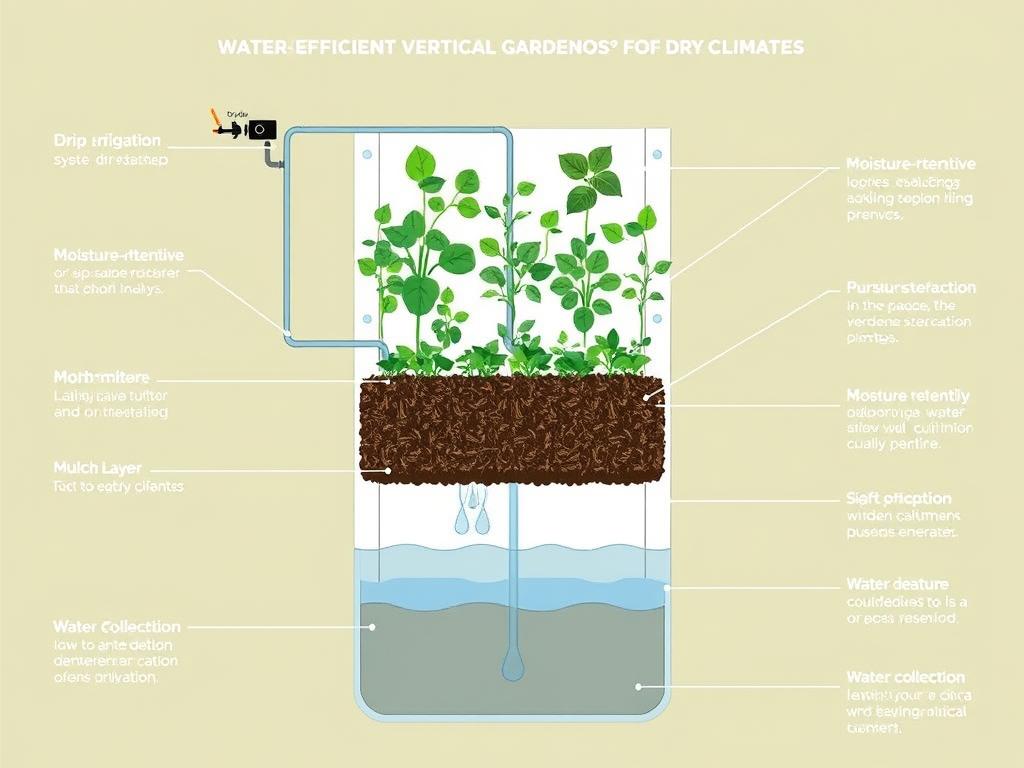
Material Choices for Dry Climate Success
Best Container Options
- Unglazed terracotta with saucers (provides cooling through evaporation)
- Self-watering containers with reservoirs
- Fabric pots with water-retention liners
- Recycled plastic with UV protection
Materials to Avoid
- Metal containers (heat up quickly in direct sun)
- Dark-colored plastics (increase soil temperature)
- Shallow containers (dry out too rapidly)
- Containers without drainage (risk of salt buildup)
Seasonal Planting Guide for Vertical Gardens in Dry Climates
This calendar is organized by season to help you plan your vertical garden for year-round productivity. Adjust planting times based on your specific hardiness zone within your dry climate region.
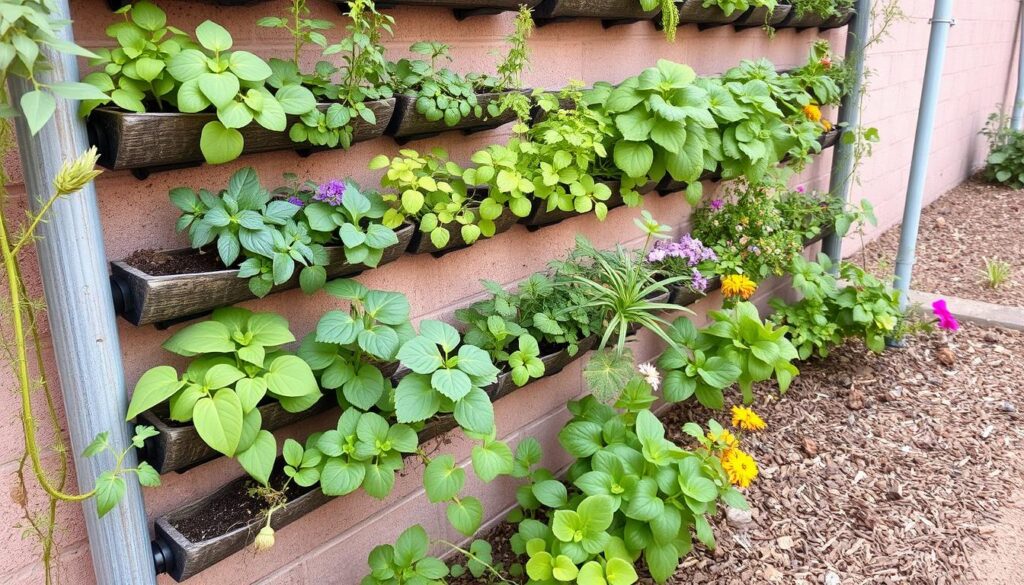
Get Your Customized Planting Calendar
Want planting dates specific to your exact location? Enter your zip code to receive a customized vertical garden planting calendar for your dry climate zone.
Spring Planting (March-May)
Spring offers ideal growing conditions in most dry climates before summer heat intensifies. Focus on establishing drought-tolerant perennials and fast-growing vegetables.
| Plant Type | Recommended Varieties | Water Needs | Spacing in Vertical Systems |
| Herbs | Rosemary, Thyme, Oregano, Sage | Low (once established) | 8-10 inches apart |
| Leafy Greens | Swiss Chard, Kale, Spinach | Moderate | 6-8 inches apart |
| Root Vegetables | Radishes, Baby Carrots | Moderate | 3-4 inches apart |
| Climbing Plants | Snap Peas, Snow Peas | Moderate | 3 inches apart, trellised |
Spring Watering Tip: As temperatures begin to rise, water deeply but infrequently to encourage deep root growth. Apply water in the early morning to minimize evaporation losses.
Summer Survival (June-August)
Summer in dry climates presents the greatest challenge for gardeners. Focus on heat-tolerant varieties and implement additional water conservation strategies.
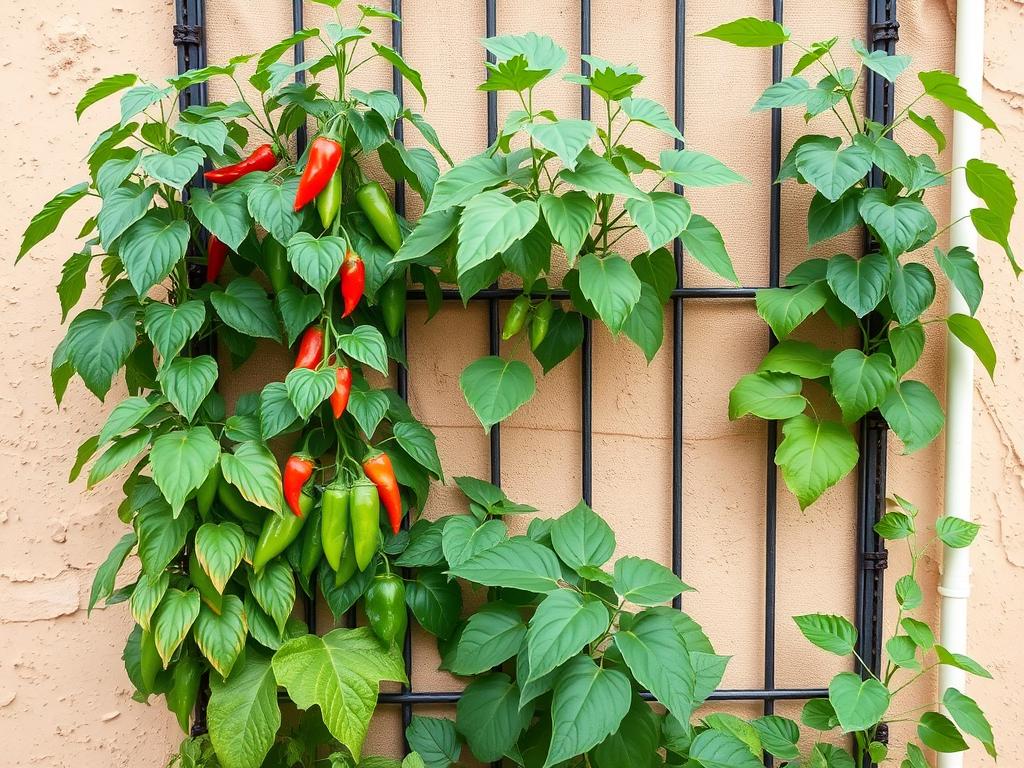
Recommended Summer Crops
- Okra – Thrives in heat and requires minimal water once established
- Peppers – Both sweet and hot varieties perform well in vertical systems
- Malabar Spinach – Heat-loving climbing green that thrives when other greens fail
- Bush Beans – Compact varieties that produce well in containers
- Herbs – Basil, oregano, and rosemary continue to thrive
Summer Irrigation Schedule
During the hottest months, follow this watering approach:
- Water deeply 2-3 times per week before 8 AM
- Check soil moisture at 2-inch depth before watering
- Apply water at the base of plants, not on foliage
- Increase frequency during heatwaves, but maintain depth
- Consider temporary shade cloth (30-40%) during extreme heat
Fall Harvests (September-November)
Fall brings relief from summer heat and offers a second growing season in many dry climates. Take advantage of cooling temperatures to grow cool-season crops.
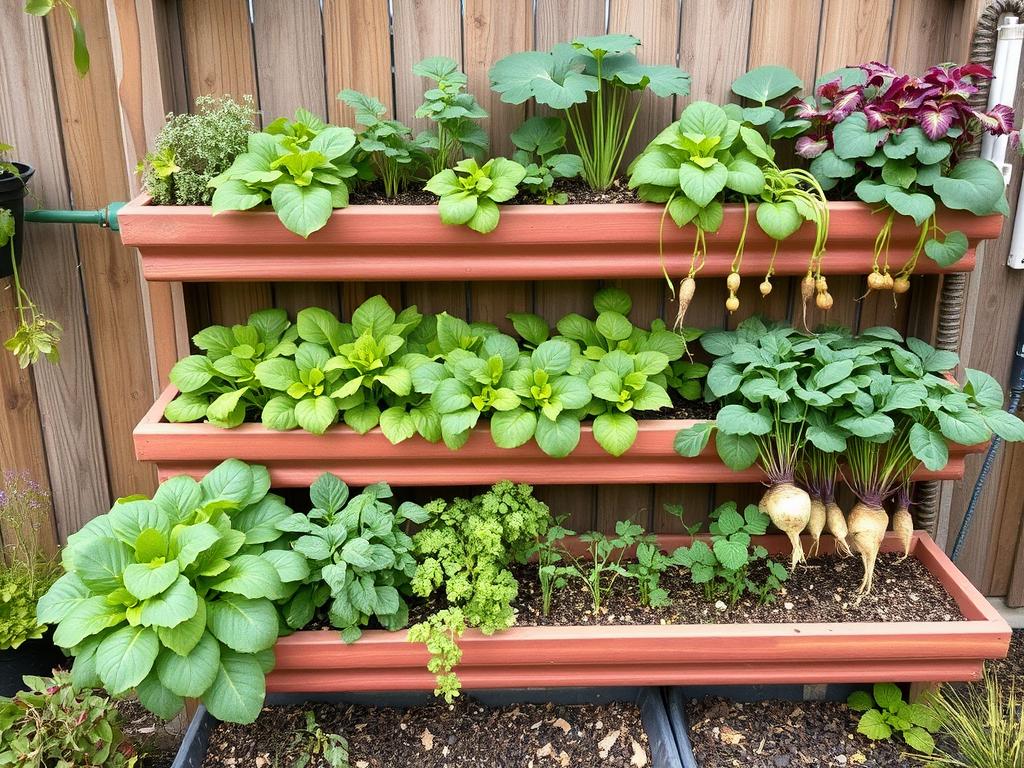
| Plant Type | Recommended Varieties | Days to Harvest | Special Considerations |
| Leafy Greens | Lettuce, Arugula, Spinach | 21-45 days | Provide afternoon shade in early fall |
| Root Vegetables | Radishes, Turnips, Beets | 25-60 days | Use deeper containers (12″+) |
| Legumes | Snap Peas, Snow Peas | 60-70 days | Provide sturdy trellis support |
| Brassicas | Kale, Collards, Mustard Greens | 50-65 days | Pest protection may be needed |
Winter Maintenance (December-February)
Winter in dry climates varies significantly by region. In milder zones, continue growing cool-season crops. In colder areas, focus on maintenance and preparation for spring.
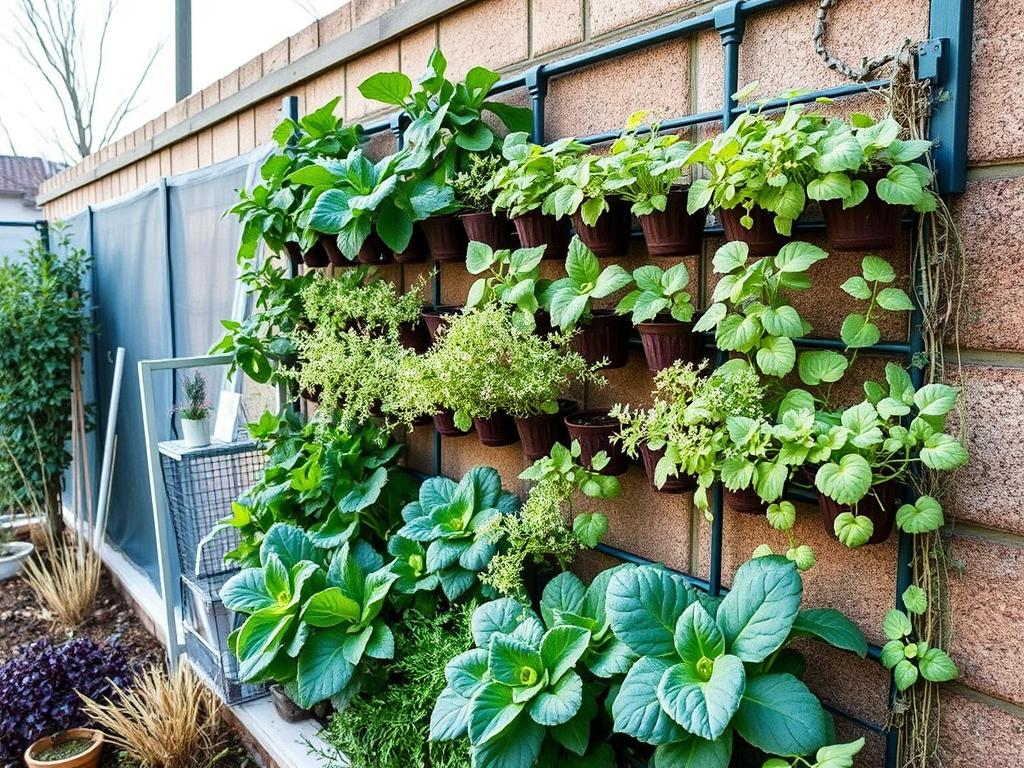
Winter Growing (Zones 8-10)
- Leafy Greens – Kale, collards, spinach
- Root Vegetables – Carrots, turnips, radishes
- Herbs – Cilantro, parsley, mint
- Peas – Plant in late winter for early spring harvest
Winter Maintenance Tasks
- Amend soil with compost in empty containers
- Clean and repair irrigation systems
- Protect frost-sensitive perennials with covers
- Prune dormant perennial herbs (rosemary, sage)
- Plan your spring garden layout and order seeds
Water-Smart Practices for Vertical Gardens in Dry Climates
Implementing water conservation techniques is essential for sustainable gardening in arid regions. These strategies will help you maximize every drop while maintaining plant health.
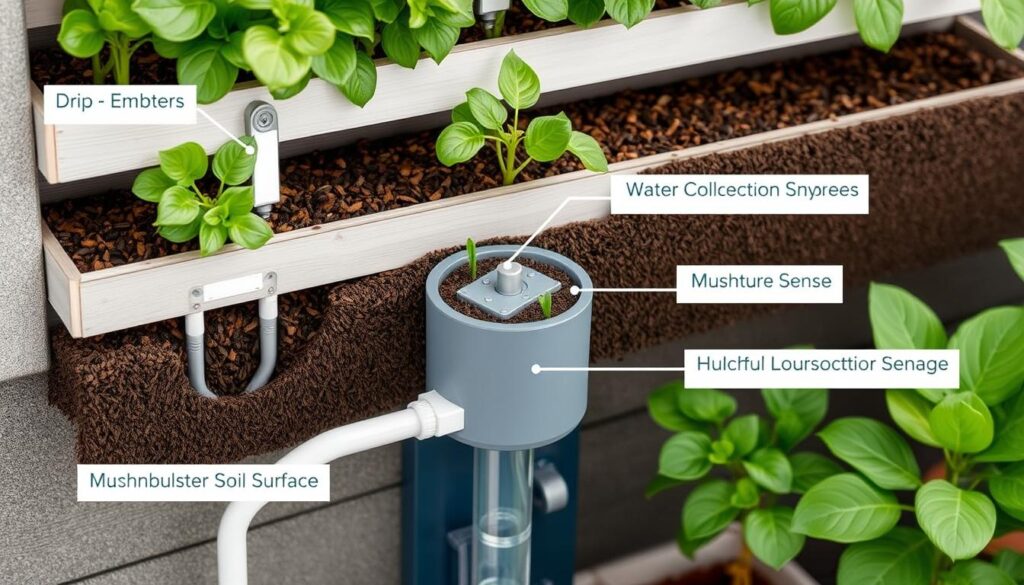
Greywater Systems for Vertical Gardens
Repurposing household water can significantly reduce your garden’s freshwater needs. Here’s a simple approach to implementing a greywater system:
Simple DIY Greywater Collection
- Place a basin in your sink when washing vegetables or rinsing dishes (avoid using soaps)
- Collect shower water while waiting for it to warm up
- Store collected water in covered containers to prevent mosquito breeding
- Use within 24 hours to prevent bacterial growth
- Apply only to ornamental plants or the base of food plants (not directly on edible parts)
Important: Check local regulations regarding greywater use. Never use water containing bleach, strong cleaning chemicals, or that has been used to wash diapers or contaminated items.
Companion Planting for Drought Resistance
Strategic plant combinations can create beneficial microclimates and reduce overall water needs in your vertical garden.
| Companion Combination | Benefits | Placement in Vertical Garden |
| Basil + Tomatoes | Basil creates humidity microclimate; deters pests | Plant basil below tomatoes |
| Rosemary + Sage + Thyme | Similar water needs; shared pest protection | Group together in upper sections |
| Nasturtiums + Cucumbers | Nasturtiums shade soil; deter cucumber beetles | Nasturtiums at edges of cucumber containers |
| Aloe + Peppers | Aloe provides shade; both have similar water needs | Aloe on sunny side of pepper plants |
Top Plant Recommendations for Vertical Gardens in Dry Climates
These drought-tolerant plants are particularly well-suited for vertical gardening in arid conditions, offering reliable harvests with minimal water input.
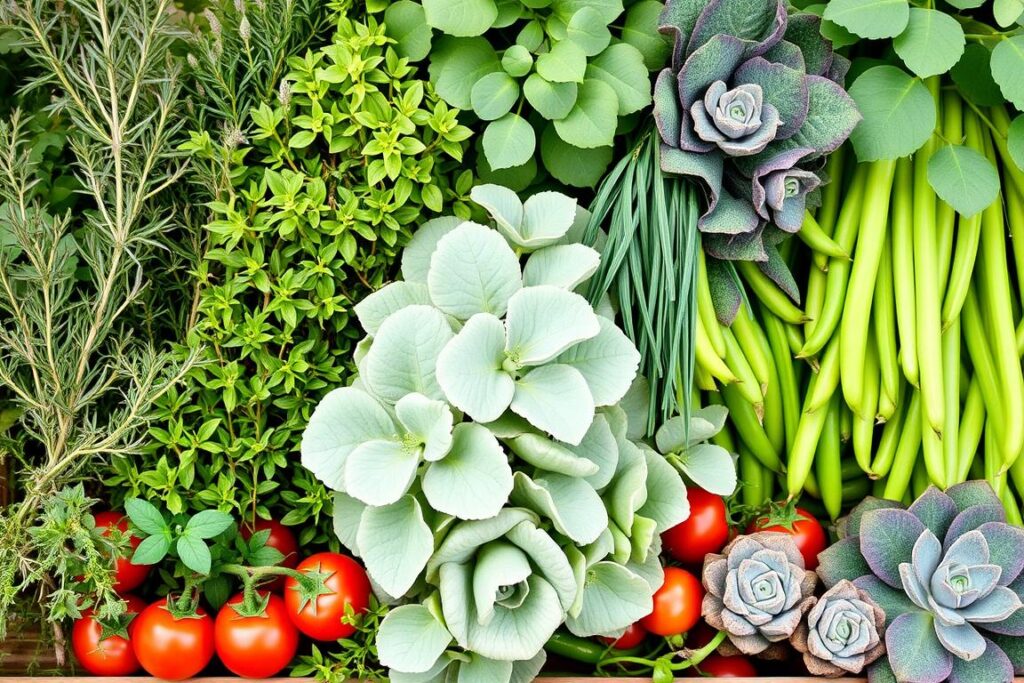
Drought-Tolerant Herbs
- Rosemary – Woody perennial with excellent heat tolerance
- Thyme – Low-growing herb perfect for vertical garden edges
- Sage – Aromatic perennial with beautiful gray-green foliage
- Oregano – Spreading herb that thrives in poor soil
- Lavender – Fragrant perennial that attracts pollinators
Water-Efficient Vegetables
- Cherry Tomatoes – Compact varieties like ‘Tiny Tim’ or ‘Patio Princess’
- Bush Beans – ‘Provider’ or ‘Contender’ varieties
- Peppers – Both sweet and hot varieties perform well
- Eggplant – Compact varieties like ‘Fairy Tale’ or ‘Patio Baby’
- Armenian Cucumber – More drought-tolerant than regular cucumbers
Ornamental Accents
- Sedum – Perfect for edges and gaps in vertical systems
- Portulaca – Colorful flowering succulent for upper tiers
- Aloe Vera – Medicinal plant that thrives in dry conditions
- Agave – Architectural accent for larger vertical gardens
- Trailing Lantana – Drought-tolerant flowering plant
Join Our Dry Climate Gardeners Community
Connect with fellow gardeners in arid regions to share tips, successes, and challenges. Get region-specific advice and seasonal reminders tailored to your location.
Maintenance & Troubleshooting for Dry Climate Vertical Gardens
Regular maintenance and prompt problem-solving are key to long-term success with vertical gardens in challenging dry environments.
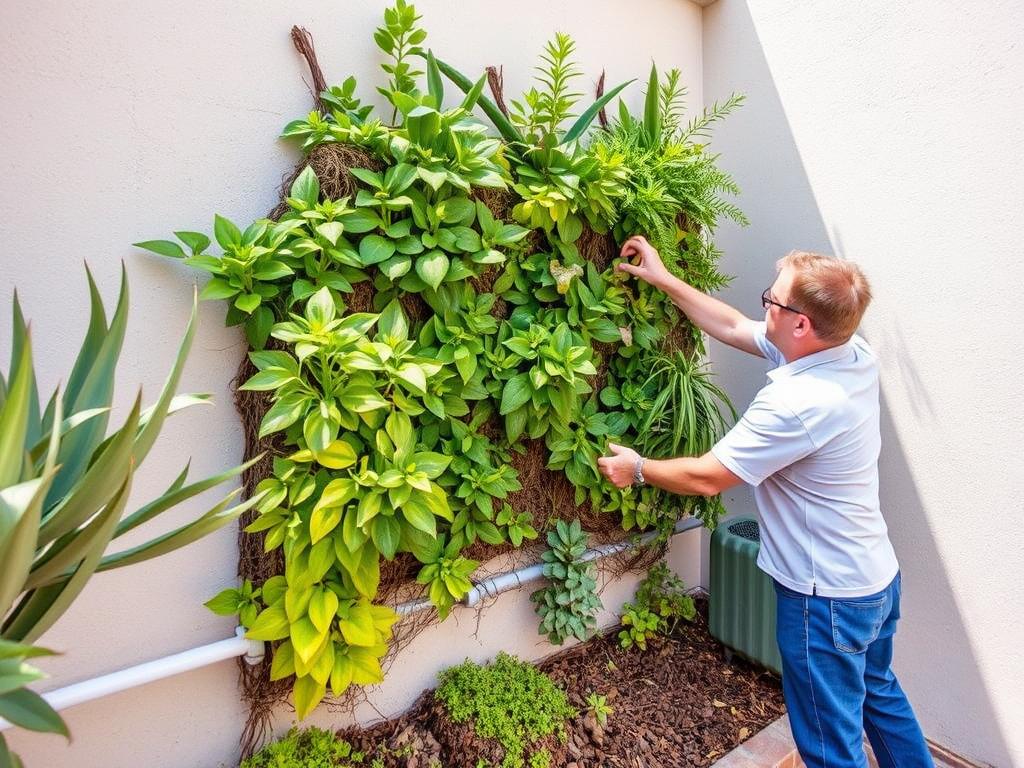
Pest Control in Dry Climates
Dry climates have unique pest challenges, often exacerbated by plant stress during hot periods. Here are natural solutions for common problems:
| Common Pest | Signs of Infestation | Natural Control Method |
| Spider Mites | Fine webbing, stippled yellow leaves | Regular strong water sprays; neem oil application |
| Aphids | Curled leaves, sticky residue | Insecticidal soap; introduce ladybugs |
| Whiteflies | Tiny white insects that fly when disturbed | Yellow sticky traps; neem oil spray |
| Ants | Visible trails, often farming aphids | Diatomaceous earth around containers |
Signs of Over/Under-Watering
Proper watering is critical in dry climates. Learn to recognize these indicators to adjust your irrigation accordingly:
Underwatering Signs
- Wilting despite cool temperatures
- Curling, dry leaf edges (crispy texture)
- Slow growth or stunting
- Premature flowering/bolting
- Soil pulling away from container edges
Overwatering Signs
- Yellowing leaves, especially lower ones
- Soft, mushy stems near soil line
- Fungus gnats present around soil
- Mold on soil surface
- Foul smell from soil (root rot)
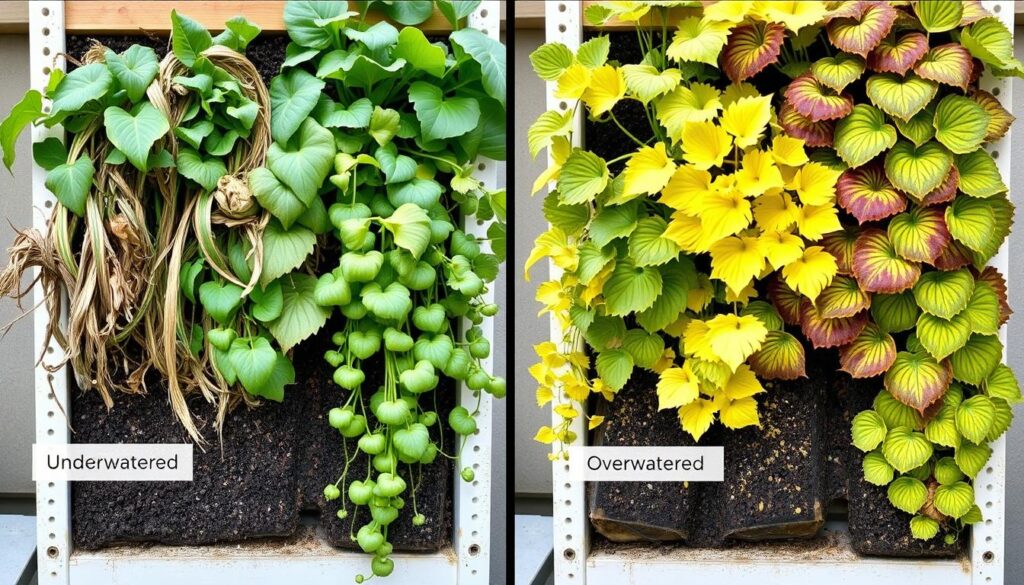
Left: Signs of underwatering | Right: Signs of overwatering
Conclusion: Thriving Year-Round with Your Dry Climate Vertical Garden
Creating a successful vertical garden in dry climates is entirely achievable with the right approach to seasonal planting and water conservation. By following this calendar and implementing the water-smart strategies outlined, you can enjoy fresh, homegrown produce throughout the year while using a fraction of the water required by traditional gardens.
Remember that local conditions vary significantly even within dry climate zones. Connect with nearby gardeners to share region-specific knowledge and adapt these guidelines to your unique microclimate. With each season, you’ll gain valuable experience about what works best in your vertical garden space.
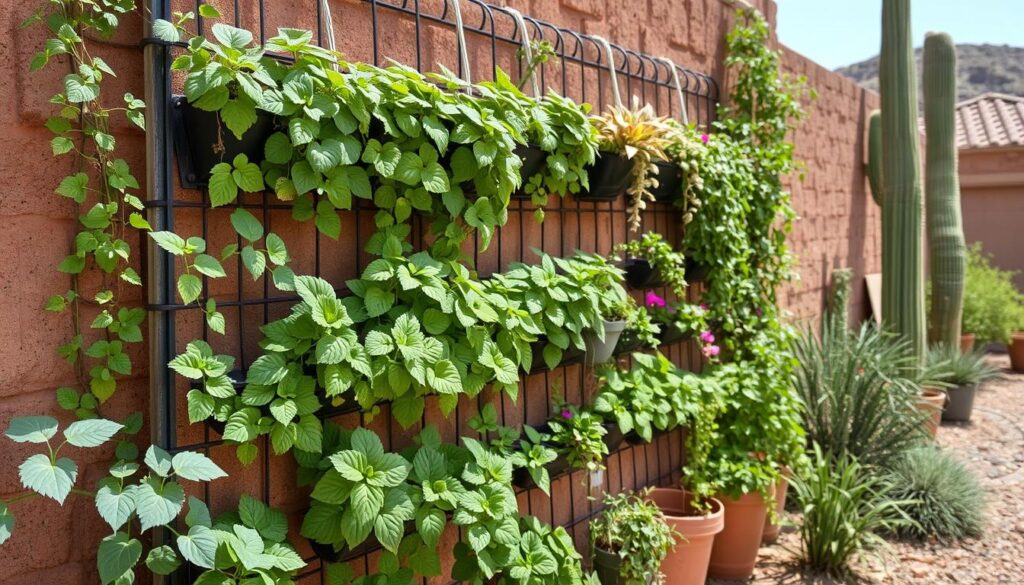
Get Your Free Seasonal Planting Calendar
Subscribe to receive our detailed vertical garden planting calendar customized for your specific dry climate zone. Plus, get monthly reminders and water-saving tips throughout the year!
Will is a vertical gardening enthusiast and sustainable cultivation specialist with a passion for helping people grow fresh food in small spaces and dry climates. With years of hands-on experience testing smart irrigation systems, optimizing urban gardens, and exploring eco-friendly solutions, this author shares clear, practical tips to turn any corner into a productive garden. Whether on a sunny balcony or in a compact backyard, Will helps readers save water, maximize space, and enjoy healthy harvests year-round. When not tending to his plants, you’ll find him sipping herbal tea and sketching ideas for new sustainable projects.

